
The Lowell Line is a railroad line of the MBTA Commuter Rail system, running north from Boston to Lowell, Massachusetts. Originally built as the New Hampshire Main Line of the Boston & Lowell Railroad and later operated as part of the Boston & Maine Railroad's Southern Division, the line was one of the first railroads in North America and the first major one in Massachusetts.
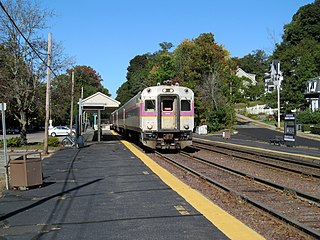
The Haverhill Line is a branch of the MBTA Commuter Rail system, running north from downtown Boston, Massachusetts through the cities and towns of Malden, Melrose, Wakefield, Reading, Wilmington, Andover, North Andover, Lawrence, and Haverhill.

The Fitchburg Cutoff was a rail line running 2.8 miles (4.5 km) from Brighton Street in Belmont, Massachusetts, to Somerville Junction in Somerville, Massachusetts. It was constructed in two segments in 1870 and 1881 to connect the Lexington Branch and Central Massachusetts Railroad to the Boston and Lowell Railroad. Passenger service lasted until 1927. Freight service ended in 1979–80 to allow construction of the Red Line Northwest Extension; the line was abandoned in three sections in 1979, 1983, and 2007.
The Lexington and West Cambridge Railroad was a railroad company chartered in 1845 and opened in 1846 that operated in eastern Massachusetts. It and its successors provided passenger service until 1977 and freight service until 1980 or early 1981.

Melrose/Cedar Park station is an MBTA Commuter Rail station located in downtown Melrose, Massachusetts. The station has two low-level platforms serving the two tracks of the Haverhill Line; it is not accessible.
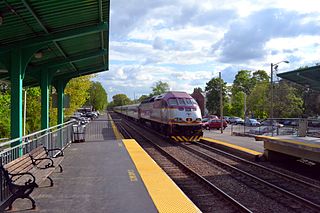
Melrose Highlands station is an MBTA Commuter Rail station on the Haverhill Line located in the Melrose Highlands neighborhood of Melrose, Massachusetts. It is the most used station in the city, and was originally planned to be a station on the cancelled extension of the Orange Line to Reading. The station is accessible.

West Medford station is an MBTA Commuter Rail station in Medford, Massachusetts. It serves the Lowell Line, and is located at West Medford Square.

Ayer station is an MBTA Commuter Rail station located off Main Street in the Ayer Main Street Historic District of Ayer, Massachusetts. It serves the Fitchburg Line. There are three tracks through the station, two of which are served by a pair of low-level side platforms, which are not accessible. There is a shelter on the inbound platform.

Littleton/Route 495 station is an MBTA Commuter Rail station in Littleton, Massachusetts. It serves the Fitchburg Line. The station is located at the intersection of Grimes Lane and Foster Street near Route 2 and I-495 and serves as a park-and-ride station for both highways.

River Works station is an MBTA Commuter Rail station on the Newburyport/Rockport Line in West Lynn, Massachusetts. The only private station on the system, it is only open to GE Aviation employees who work at the adjacent River Works plant. The station has minimal facilities – two small sections of platform and several shelters – and is not accessible.

Lynn station is an intermodal transit station in downtown Lynn, Massachusetts. It is a station on the MBTA Commuter Rail Newburyport/Rockport Line and a hub for the MBTA bus system. The rail station and parking garage temporarily closed on October 1, 2022, pending a reconstruction project, while the busway remained open. Interim platforms nearby opened in December 2023.

Prides Crossing station is a former MBTA Commuter Rail station on the Newburyport/Rockport Line, located in the village of Prides Crossing in Beverly, Massachusetts. It was opened by the Eastern Railroad as a flag stop in the mid-19th century. A stick style wooden station building was constructed around 1880 as wealthy residents built summer homes in the area. The Eastern Railroad was acquired in 1885 by the Boston and Maine Railroad (B&M), which operated commuter service to Prides Crossing until the Massachusetts Bay Transportation Authority (MBTA) took over in the 1970s. Prides Crossing was reduced to peak-hour-only service in 1981. It was temporarily closed in December 2020 because of low ridership and a lack of accessibility, with the closure becoming indefinite in April 2021. The former station building, not used by the railroad since the mid-20th century, is occupied by a private business.
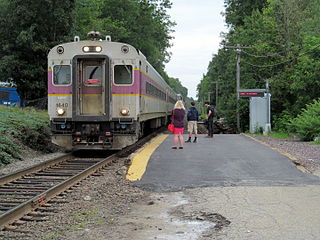
North Wilmington station is an MBTA Commuter Rail station in North Wilmington, Massachusetts. It serves the Haverhill Line, and is located off Middlesex Avenue (Route 62). It has some of the most limited station faculties on the MBTA system – a single short non-accessible platform serving the line's single track at the location, with a small parking lot and shelter for passengers. North Wilmington served by most Boston–Haverhill trains except for a small number that use the Wildcat Branch. It is a flag stop except during weekday peak hours.
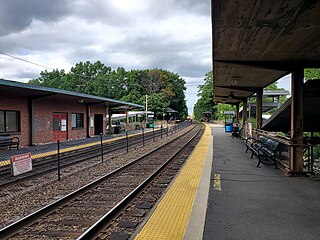
Wedgemere station is an MBTA Commuter Rail station in the southeast portion of Winchester, Massachusetts, served by the Lowell Line. The station has two side platforms serving the line's two elevated tracks. The 1957-built station building, largely unused, is adjacent to the inbound platform. After several years of work, the station was made fully accessible in February 2013.
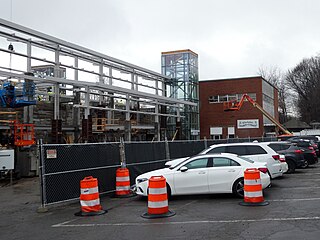
Winchester Center station is a temporarily closed MBTA Commuter Rail station in Winchester, Massachusetts, normally served by the Lowell Line. The station, located on a viaduct in downtown Winchester, was closed effective January 8, 2021 due to structural deterioration. Winchester Center station was not accessible prior to the closure, but accessible high-level platforms are being added during renovations taking place from December 2021 to October 2024.

Mishawum station is an MBTA Commuter Rail Lowell Line station located in the north part of Woburn, Massachusetts just north of the Route 128/I-95 beltway. The station has two side platforms serving the line's two tracks. Mishawum is a limited-service flag stop intended for reverse commuting to the adjacent office park, with no weekend service. With just 32 boardings on an average weekday in 2018, Mishawum is one of the least busy stations on the commuter rail system.
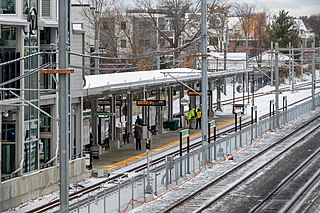
Magoun Square station is a light rail station on the Massachusetts Bay Transportation Authority (MBTA) Green Line located at Lowell Street south of Magoun Square in Somerville, Massachusetts. The accessible station has a single island platform serving the two tracks of the Medford Branch. It opened on December 12, 2022, as part of the Green Line Extension (GLX), which added two northern branches to the Green Line, and is served by the E branch.

Lake Street station was a commuter rail station on the Lexington Branch, located in the East Arlington section of Arlington, Massachusetts. The line opened as the Lexington and West Cambridge Railroad in 1846, with a station at Pond Street among the earliest stops. It was renamed Lake Street in 1867. The Boston and Lowell Railroad (B&L) acquired the line in 1870 and built a new station building in 1885. Service continued under the Boston and Maine Railroad (B&M) – successor to the B&L – though it declined during the 20th century. Lake Street station and three others on the line were closed in May 1958. The Massachusetts Bay Transportation Authority (MBTA) began subsidizing service in 1965, and Lake Street station reopened in March 1968. All passenger service on the Lexington Branch ended on January 10, 1977; it was converted into the Minuteman Bikeway in the early 1990s.

Beaver Brook is a former MBTA Commuter Rail station in Waltham, Massachusetts. It served the Fitchburg Line. It was located near Main Street east of the center of town, and was named after a nearby brook of the same name.
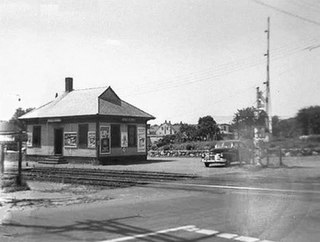
Cross Street station was an MBTA Commuter Rail station in northern Winchester, Massachusetts, on the border with Woburn. The station first opened in the mid-1840s as Richardson Row on the Woburn Branch Railroad, part of the Boston and Lowell Railroad (B&L). It was renamed Cross Street in 1876. The Boston and Maine Railroad (B&M) leased the B&L in 1887, built a new depot at Cross Street in 1893, and replaced it with a concrete shelter in 1955. The Massachusetts Bay Transportation Authority (MBTA) began subsidizing service on the Woburn Branch in 1965 and purchased the line in 1976. The station was closed along with the Woburn Branch in 1981.





















